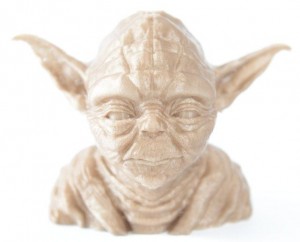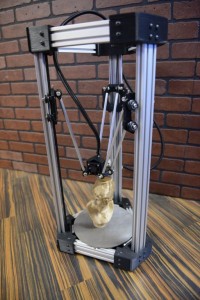The other day I posted about a new 3D printer that showed up on popular crowd funding website Kickstarter. The “Delta Maker” utilizes existing technology and unique design to deliver an aesthetically pleasing 3D printer that hobbyists and makers would be proud to display on their desktop.Check out the DeltaMaker campaign on KickStarter – they are now fully funded but there are a number of printers left. I had a chance to discuss some of the details about the project with one of the DeltaMaker Co-Founders, Zack Monninger just before they reached funding. Below is the result of our discussion.
3DEngr: How long was DeltaMaker in the works before you decided to turn it into a Kickstarter project?
Zack: From the very time any of thought “Hey, I should build a 3D printer”, it’s about a year. The current product you see has been in active development for about 6 months. Kickstarter is a great way to test the market for interest before investing some of the capital needed to produce something at quantity.
3DEngr: Is this a stand alone project for you and the team or are you looking to follow up with market release, if so do you have a distribution or marketing approach in place?
Zack: We plan to sell assembled DeltaMakers via our website, www.deltamaker.com, for $1,999 moving forward. The personal 3D printing market is evolving rapidly, so plans are great, but we have to be able to pivot and adjust to the market moving forward. Since the campaign launched, we have received interest from around the world, reaching out for distribution deals. We are taking it one step at a time.
3DEngr: One of the things that I love about the new developments in additive manufacturing are the innovative things people are printing. 3DEngr has covered a bit about printing in living cells, chocolate, and even paper. I had to ask Zack:
What materials can you print with Delta Maker?
Zack: The test prints we have shown are in PLA. The model we ship will be capable of printing in ABS as well. The platform suits itself well to other printing technologies, so we will evaluate material technologies as we move forward. For the purposes of Kickstarter, it prints PLA or ABS filament.
 |
| Yoda – Printed from the Delta Maker in PLA (Polylactic acid or polyactide) |
3DEngr: As it (The Delta Maker) is based off of open source tech can you explain what your team has added in terms of technology?
Zack: Design is the big thing. There are other delta kits on the market, and you can source and design your own. In the end, we believe we nailed the product design. We’ve had people message us sort of in disbelief since they couldn’t see the motors or wires. Getting the engineering aspects to seamlessly mesh with the aesthetic aspects is why we are using the term “elegant” to describe the printer.
3DEngr: Obviously this is more than a kit since the rewards are actual machines, is there assembly required for backers? Do you have any plans to release the design, in keeping with the open source theme?
Zack: We only intend to delivered finished assemblies, so there is no anticipated assembly for backers beyond plugging it in. At this time, we don’t have a plan to release the design, though we are being open with the components we are using on the project.
 |
| The elegant and clean design of a fully assembled Delta Maker |
3DEngr: Another key concern I always have with printers is how easy they are to control. Unlike word processing and desktop printing, many 3D designs still require the skills and expertise of professional product designers, industrial or mechanical engineers. Which led me to my next questions for Zack:
What is the software platform used to control, what file types can be printed and how does a casual user manage this, is the system plug and print or dos it require some level of expertise?
Zack: Printing 3D parts still requires some heavy lifting on the part of the user. The open source tool Repetier Host is what most users will use to get data from 3D model over to the printer. There are many parameters the user can control so they still serve an integral role in the process. We intend to provide an SD card with ready-to-print code for several models. We have a few other things up our sleeve for the future….
3DEngr: Do you have any plans to scale the machine to a larger build window? (Side note, I would personally love to see a massive one of these as an installation art piece. If you kickstarter that or are pursuing as a marketing gimmick just let me know where and how to be involved?)
Zack: The design itself is scalable. For the purposes of the campaign, we are locking things down to support a move to manufacturing these in volume. We have received many questions on this topic and it clearly seems there is a demand for a bigger DeltaMaker. One step at a time…
3DEngr: What experience with 3d printers has your team had in the past? When did you first see the tech, use it, or get excited about it?
Zack: Personally, I’ve been exposed to 3D printing since college (early 2000’s). At that time, I don’t think the term 3D printing was used – we called it “Rapid Prototyping”. Most of my experience was on the end user side. I needed parts prototyped for form/fit/function testing and rapid prototyping was the best way to do that. Some of the other guys have similar industry experience. When it comes to designing and a 3D printer, this is our first effort.
Thanks to Zack for his time and all of the responses and best of luck to him and his team. To read more about 3D printing on 3DEngr check out all of our recent posts.

